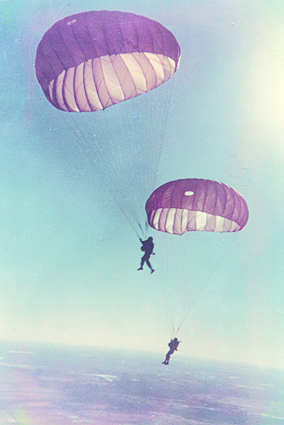 Paratrooper's
Paratrooper's

No soldier in the world is part of a prouder tradition than the American paratroopers. The story of the paratrooper is one of pride and esprit,courage and strength, confidence and comradeship. Great acts of courage and daring have been the rule whenever the American paratroopers have fought, and time and time again the American tough, versatile airborne units have won glorious victories under the most impossible conditions of battle. The proud airborne legacy was forged in World War II battles with names such as Anzio, Salerno, Sicily, Normandy, Bastogne, Nijmegen, Eindhoven, Wesel, Luzon, and Corregidor. Paratroopers are not born—they are made. Airborne “Jump” training is considered the roughest, most intensive training in the Army. He must be toughened physically and conditioned mentally so that he will not only unhesitatingly jump from an aircraft, but so that he will land ready for battle more than the equal of any soldier that an enemy can put on the battlefield against him.
Parachutist Badge (Jump Wings)
The most sought after paratrooper insignia is the parachutist badge, or
"wings." It is a proud moment for any soldier when they are first pinned on
him. A paratrooper has good reason to be proud of the parachute wings he wears,
for they are a symbol not only of what he has been through, but also of what he
is prepared to go through. His jump “wings” are among his most prized
possessions and his other distinctive airborne emblems and insignia, are among
the most coveted and honored in the U.S. Army. So proud are the troopers of
their emblems, that some have wings tattooed on their chests and arms.
There are three types of wings: Parachutist, Senior Parachutist, and Master
Parachutist, and the requirements to win them are among the strictest and most
rigorous in the Army. A bronze star may be worn on the wings for each combat
jump in which the paratrooper has participated.
Parachutist Badge with Bronze Star
To earn the Parachutist Badge, a soldier must have satisfactorily completed the
prescribed proficiency tests while assigned or attached to an airborne unit or
the Airborne Department of the Infantry School; or have taken part in at least
one combat jump into enemy-held territory as part of an airborne assault
landing.
Senior Parachutist Badge
To earn the Senior Parachute Badge, a trooper must make at least 30 jumps—to include 15 jumps with combat equipment, two night jumps (one of which must have been, as stick jumpmaster), and two mass tactical jumps. He must be a graduate of jumpmaster school or have served as jumpmaster on one combat jump or 15 non-combat jumps. He must also have at least 24 months on jump status with a unit authorized parachutists.
The Master Parachutist Badge is the most difficult to earn. Some of the requirements the a master parachutist must meet are: a minimum of 56 jumps—to include 25 jumps with combat equipment, four night jumps (one of which must have been as stick jumpmaster), and five mass tactical jumps. He must also be a graduate of jumpmaster school or have served as jumpmaster on one combat jump or on 33 non-combat jumps. He must have at least 36 months on jump status with a unit authorized parachutists.
The airborne “glider” patch is another distinctive mark of the paratrooper,
which is worn by enlisted men on the left front of the garrison cap, and on the
right front for officers. It is tradition for a paratrooper to sew a silver
dollar beneath the patch so he will always have money to purchase “the good
things” in life (alcohol and a female’s favor) no matter where he travels.
Jump Boots
The paratrooper considers his boots as one of his prized emblems. They must always be highly polished, precisely laced, and his trousers must blouse over them in a carefully prescribed manner. Paratroopers are always annoyed to see "straight-legs" (non-jumpers) wearing jump boots, and there was a time when a "straight-leg" if caught wearing jump boots would have them cut down to oxfords in record time.


